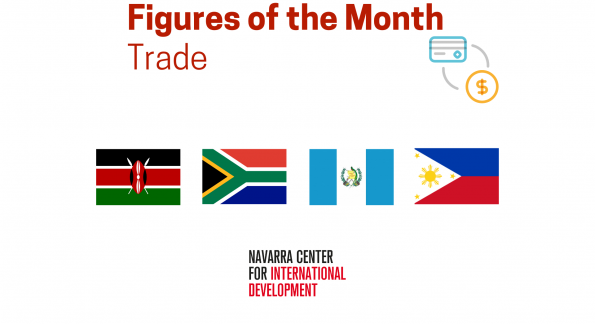
The Navarra Center for International Development produces a series of figures each week focusing on a topic per month. In March it was Trade. Here is an analysis by regions.
Sub-Saharan Africa
South Africa and Kenya are two important countries in the African trade market. However, each has a very different market. The former is the leading country in both exports and imports in Africa and sustains its positive commercial balance in the export of minerals such as gold, platinum and iron ore, amongst others. The latter is the 7th regional exporter and its value of exported goods and services has grown from 7.42 to 11.8 billion USD in a decade, from 2009 to 2018. Kenya relies heavily on the export of tea and cut flowers, which together account for more than 25% of its exports. As of today, Kenya is the third largest exporter of cut flowers in the world, providing 40% of all the ones that arrive into the EU, its main partner for this good.
Despite their vast differences, one focused on minerals and the other on agricultural products, South Africa and Kenya do have in common their main import partner: China. The Asian country accounts for 18.2% of South Africa’s imported products and 23.9% of those coming to Kenya, with a wide variety of products ranging from technological equipment to clothing and infrastructure parts.
The kickoff of the African Free Trade Agreement is a vast opportunity for both countries to widen up their markets inside the continent. Whilst Kenya does have Uganda as its main export partner, South Africa relies heavily on non-African countries, especially on Middle-East and Asian nations. The AFCfTA expects to increase intra-african trade from 12% to 50%, in line with trade within other regions such as Europe. This could lead to an increase in the export of their main products to sister African nations.
Southeast Asia

The Philippines is the sixth largest exporter and importer in Southeast Asia, behind Singapore, Thailand, Vietnam, Malaysia and Indonesia. In the last decade, the country was one of the fastest growing exporters in the region, with trade playing a significant role in GDP growth between 2012 and 2017.
In terms of imports, these increased by 15% from 2017 to 2018 and total trade accounted for 76.1% of GDP, after having been on a growth trend since 2013.
Central America

Guatemala is the largest exporter in the Northern Triangle and one of the fastest growing Central American exporters. Among other things, thanks to CAFTA-DR, a free trade agreement between the United States, Central America and the Dominican Republic that has stimulated its growth.
It is also the second largest importer in Central America, behind Panama. Between 2017 and 2018, it increased its imports by 7% and total trade accounted for 45.8% of GDP in 2018.








